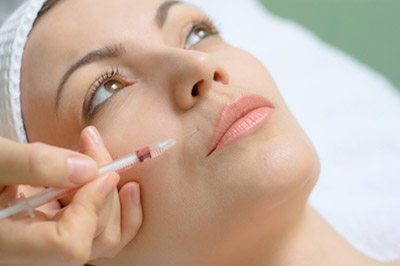Facial Injections

In the United States, people of all ages have flocked to the plastic surgeons office in hopes of erasing wrinkles and achieving a smoother, more attractive look. Not surprisingly, minimally-invasive injectables have won the intrigue of many, and have become an easier, less intimidating alternative for people hoping to dip their toes into the waters of cosmetic procedures.
Botox®: Derived from a neurotoxin called botulinum toxin, this anti-aging treatment is injected directly into the muscles that cause skin creasing, with the intention of temporarily immobilizing them and ultimately reducing the look of wrinkles.
The most common injection sites are crow’s feet around eyes and in frown lines in between eyebrows. Botox® can also be injected in areas of the forehead to reduce the appearance of expression lines and in areas around the mouth to reduce laugh lines.
Botox® has even been used in migraine suffers and in people with over active armpit sweat glands, though facial application is most common.
Although generally considered a safe procedure, there are small risks associated with Botox®. Rarely, patients can experience difficult swallowing, speaking, or breathing. More serious complications have been reported, although such cases are very rare.
Results of Botox® last, on average, anywhere from 3 to 4 months.
It’s a common practice to combine Botox and a dermal filler together to not only immobilize the muscles that cause wrinkles, but also to fill and plump them, helping the problematic signs of aging both today, and later down the line.
Some of the most common dermal fillers are: Juvaderm, Restylane, Artefill, Radiesse and Autologous Fat.
Juvéderm®: Made from lab-synthesized hyaluronic acid, Juvéderm® is available in several different forms, for different problems: Juvéderm® Ultra is used to plump surface lines and wrinkles, while the Ultra Plus version is used for more depressed folds of skin.
Juvéderm® Ultra XC and Ultra Plus XC contain lidocaine, in addition to its filling properties, to reduce pain and discomfort while being injected.
Juvéderm® Voluma, on the other hand, contains a much thicker form of hyaluronic acid gel that’s used in the chin and cheekbone areas that have seen significant volume loss. This particular formula should not be used in areas around the lips or eyes.
Results can last anywhere between 6 months to 2 years, depending on your skin, aging, areas being injected, and the type of Juvéderm® used.
Restylane®: Another form of hyaluronic acid, Restylane is derived from bacteria and is typically used for less significant wrinkling.
Results obtained with Restylane can last between 6 months and 1 year.
Artefill – Contains a synthetic ingredient, PMMA, or polymethyl methacrylate, mixed with collagen derived from animals.
This injectable is considered “semi-permanent” since it does not reabsorb into the body like other dermal fillers. As such, it may carry higher risks. Lumping of the product, nodules, and filler migration are possible, though these potential side effects are not common.
If migration, lumping, or nodules do become present, the removal of said lumps or nodules can be a difficult process. Due to its semi-permanent nature, however, Artefill does require far less maintenance than other fillers, lasting upwards of 5 years.
Radiesse® – Used for deep wrinkle issues, Radiesse® is also a semi-permanent filler that is comprised of calcium hydroxyapatite, a compound that’s typically used to heal different skeletal defects.
Results of Radiesse last upwards of 2 years.
Autologous Fat – One of the most “natural” types of fillers that can be used, autologous fat is grafted from your own body through a liposuction procedure.
Removing and re-injecting fat back into the body is an involved, multi-step process. Usually safe and successful, in rare instances the procedure could result in migration or bunching of the injected fat, though that is not a common occurrence.
Results of this type of filler can last anywhere from 12 to 24 months.
The type of filler that your doctor may use usually depends on several factors: your signs of aging, skin, and perhaps your physician’s personal preferences.
It’s important to do as much research as possible before your doctor’s visit to familiarize with the different types, so you can make the most informed decision possible.
Though these fillers, and those similar to the ones mentioned, are very popular and widely considered safe, some don’t feel comfortable with the idea of needles and going under the knife.
For those that are apprehensive to try cosmetics procedures, there are effective topical products available that come close to mimicking the effects of injections. Relaxing agents included in serums can help achieve an effect similar to a small amount of Botox®, while plumping agents may be included to mimic the effects of dermal fillers.
One such product is our very own Venox, formulated with the synthetic relaxing agent SYN®-AKE, plus Palmitoyl Tripeptide-5, which stimulates collagen production for a filler-like plumping effect.
Such products also work well for those who have already committed to the needle, to help maintain their smoother, younger look in between appointments, and possibly even help the effects of their injection last longer.
 In the United States, people of all ages have flocked to the plastic surgeons office in hopes of erasing wrinkles and achieving a smoother, more attractive look. Not surprisingly, minimally-invasive injectables have won the intrigue of many, and have become an easier, less intimidating alternative for people hoping to dip their toes into the waters of cosmetic procedures.
In the United States, people of all ages have flocked to the plastic surgeons office in hopes of erasing wrinkles and achieving a smoother, more attractive look. Not surprisingly, minimally-invasive injectables have won the intrigue of many, and have become an easier, less intimidating alternative for people hoping to dip their toes into the waters of cosmetic procedures.